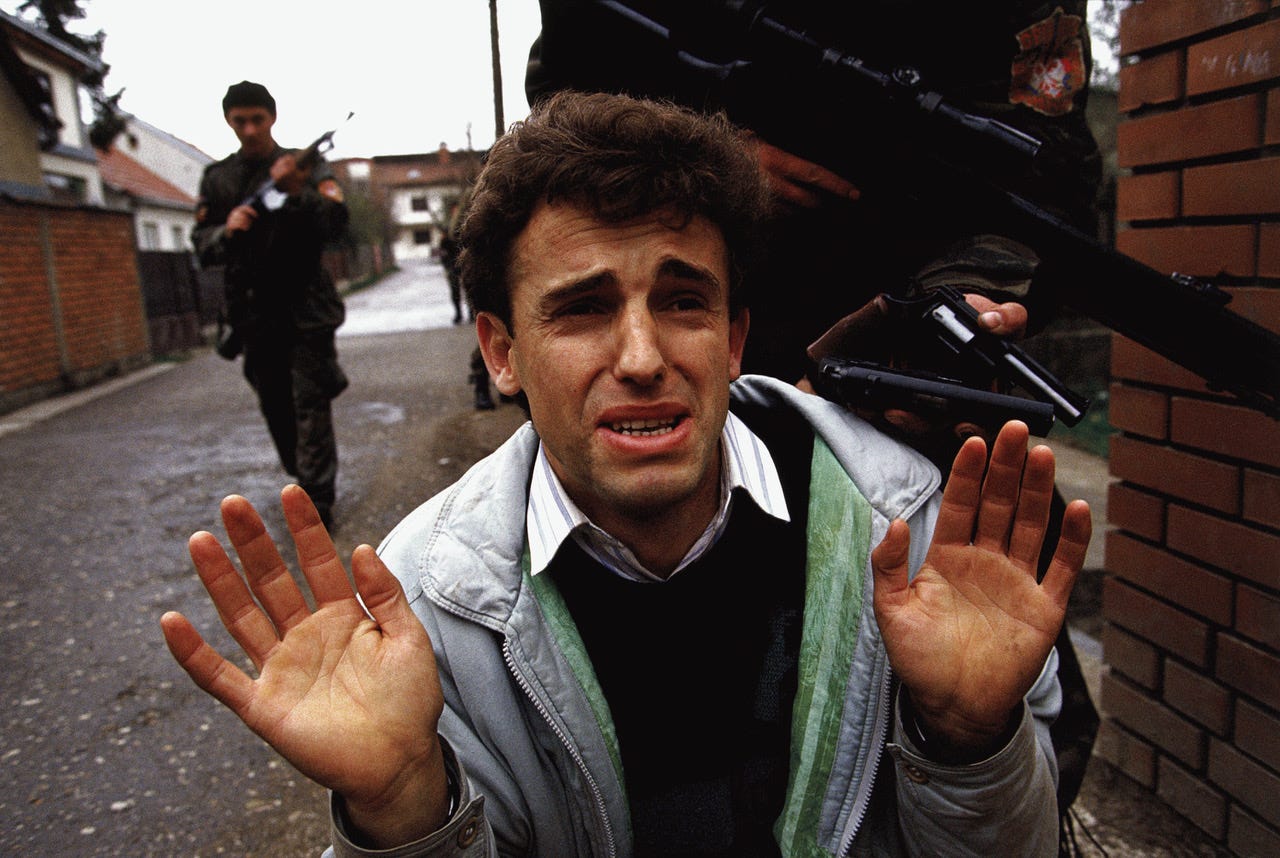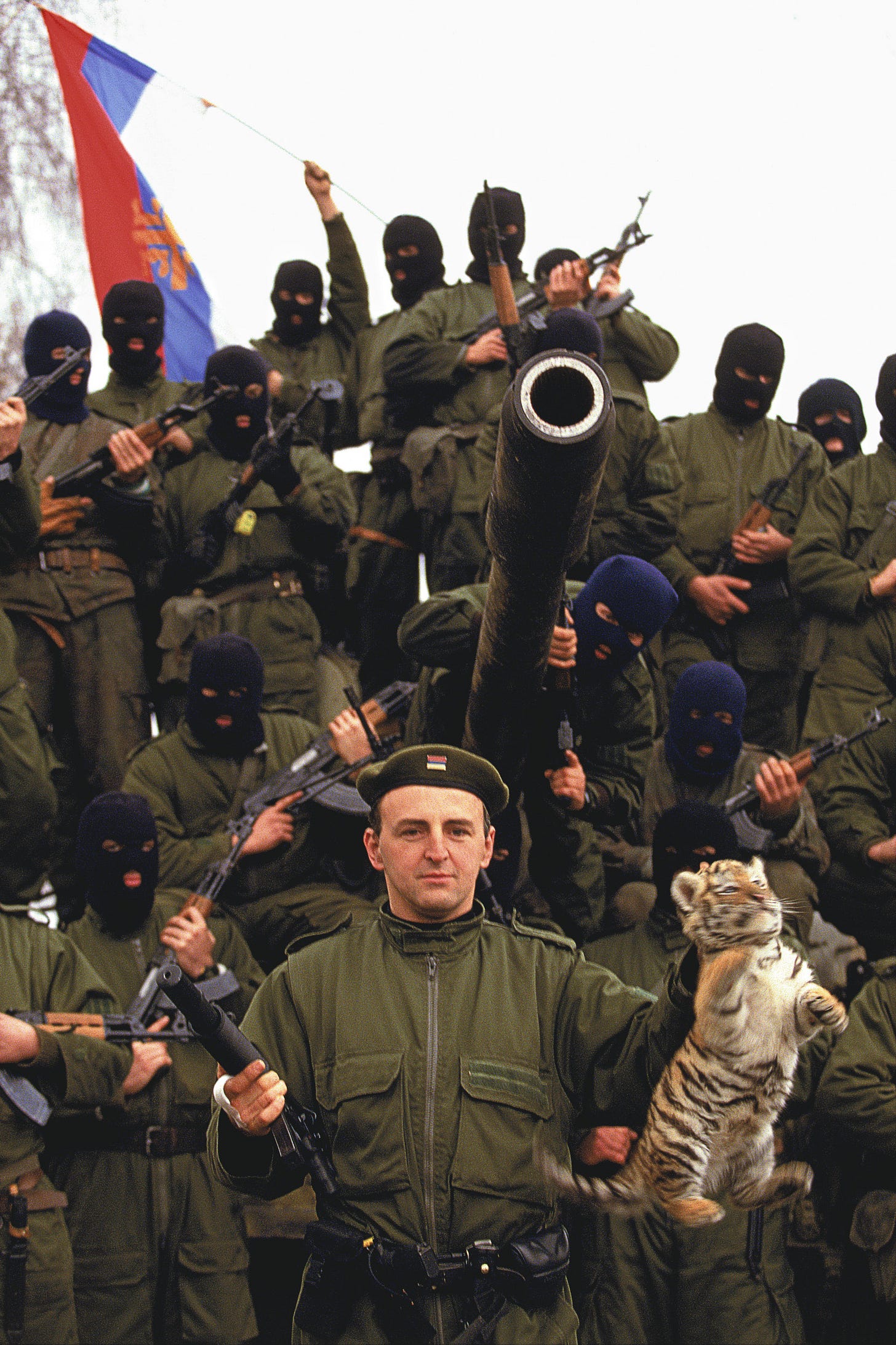Embedded with the enemy – Ron Haviv and Arkan’s Tigers
What happens when a war photographer points their camera at evil, and it smiles back?
In April 1992, in the early days of the Bosnian War, a man named Hajrush Ziberi crouched on the pavement of a small town called Bijeljina. His arms were raised. He was begging for his life. A group of Serbian paramilitaries claimed he was an insurgent. A few moments later, he was dead.
The only reason we know any of this happened is because it was photographed in what became one of the most iconic images from the conflict.
Standing a few feet away was American photojournalist Ron Haviv, camera in hand, documenting what would become one of the first recorded acts of ethnic cleansing in the war as the country formerly known as Yugoslavia fell apart.
His photographs of that day are now infamous as a warning the world failed to heed.
Haviv had been working in the Balkans long before Bijeljina. The year before, in Croatia, he had taken a different kind of photo that got him close to Arkan’s Tigers that he would later end up documenting in far darker circumstances.
The image showed Željko Ražnatović, better known by his nom de guerre – ‘Arkan’, posing in a staged photo atop a tank, surrounded by masked gunmen from his paramilitary unit the Serb Volunteer Guard, or Arkan’s Tigers. He’s holding a tiger cub in one hand, a machine gun in the other.
Arkan understood how to use the media to his advantage. A former gangster before the break-up of Yugoslavia, he was adept at manufactured his own image as a Serb hero and celebrity. He wore designer suits when entertaining journalists in Belgrade at the Hyatt Hotel and his marriage to Serb rock diva Ceca was a national television occasion.
Haviv later admitted that he was “charming, extremely smart and deceptively evil…He was a likable guy, except that he was a pathological killer.”
Arkan knew the value of performance and he let Haviv take the photo of him and his unit because it suited him. What Haviv didn’t know at the time was that the staged “victory picture” would be what gave him frontline access to the actions of Arkan and his men.
When Haviv embedded with Arkan’s unit as they crossed into Bosnia, he didn’t expect to witness a massacre. He thought he was there to document soldiers in action.
In Bijeljina, civilians were being dragged from their homes. Shops were looted. Men were lined up, accused of crimes with no evidence and executed. Haviv was told one man, Hajrush Ziberi, was an insurgent. He asked if he could take a photograph. The soldiers agreed. They placed pistols near the man’s body, props to support their story. Haviv took the photo and moments later Ziberi was dead.

The photo is brutal not because of what it shows explicitly, but because of what it suggests: a man on the verge of execution, condemned without trial, framed by a lie. It’s a moment of raw vulnerability. The soldiers remain on the edge of the frame. The focus is on Ziberi, arms out, pleading with the viewer.
There’s a disturbing kind of theater that unfolds in these moments. Everyone knows the camera is there. Everyone plays their part. Arkan and his men weren’t hiding. They were performing. For each other, for the lens, for the myth they were building. Haviv unwittingly became part of the performance.
This is the tension at the heart of war photography. The camera doesn’t just record—it shapes. It can expose a lie, or it can be used to sell one. Arkan himself later said, “The photographer that made these is a friend of mine. I let him show these photos to the world.” He thought the images Haviv recorded told the story on his terms.
As a historical record the images are important, as they are the only images made by a photojournalist of ethnic cleansing taking place in Bosnia. But the original impact of these photos was slower than Haviv expected. Despite their power they did not spur any immediate intervention to stop the killing. “The photos really didn’t have the effect that I had hoped they would. I was hoping to prevent the war, and of course there was no reaction,” he later said.
Eventually, the photos Haviv took in Bijeljina were submitted as evidence in The Hague. The International Criminal Tribunal for the former Yugoslavia used them to help build cases against war criminals. The wheels of justice moved slowly.
Arkan was indicted but never stood trial. He was assassinated in 2000 in the lobby of a Belgrade hotel. Many of his Tigers escaped prosecution altogether. In parts of Serbia, Arkan is still remembered as a hero, a popular subject of nationalistic graffiti and social media posts, many of which use Haviv’s “victory pose” image.
Haviv’s photos remain some of the rawest images from the Bosnian War. But their legacy, like many images of war ripped from their context, is also contested as they’ve been twisted and repurposed.
The photos are part of the historical record now. They document more than war—they document complicity, denial, and the strange limbo that exists between exposure and justice.
War photographers walk a line most of us never have to face. They are there to see, to record, and to survive. Yet sometimes, by doing their job, they become part of the story they’re trying to tell.
Ron Haviv pointed his camera at evil and evil smiled back.
This year Bosnia will mark 30 years since the end of the war which tore the country apart. Between 2018 and 2021 I spent several years covering different aspects of the conflict, its aftermath and it still effects people today. I will be returning to Bosnia in July and leading up to that I am revisiting some of my old work produced during my time there.
I originally wrote this essay as part of my university course at LCC, where I first began producing work on the Balkans. It is inspired by an article by the late Paul Lowe titled ‘Picturing the Perpetrator.’ Paul was one of the people that first inspired me to travel to Bosnia produce documentary work there. He covered several conflicts but was most drawn to Bosnia where he eventually ended up living. Paul sadly passed away this year, a great loss to the photojournalism community.




A chilling reminder...